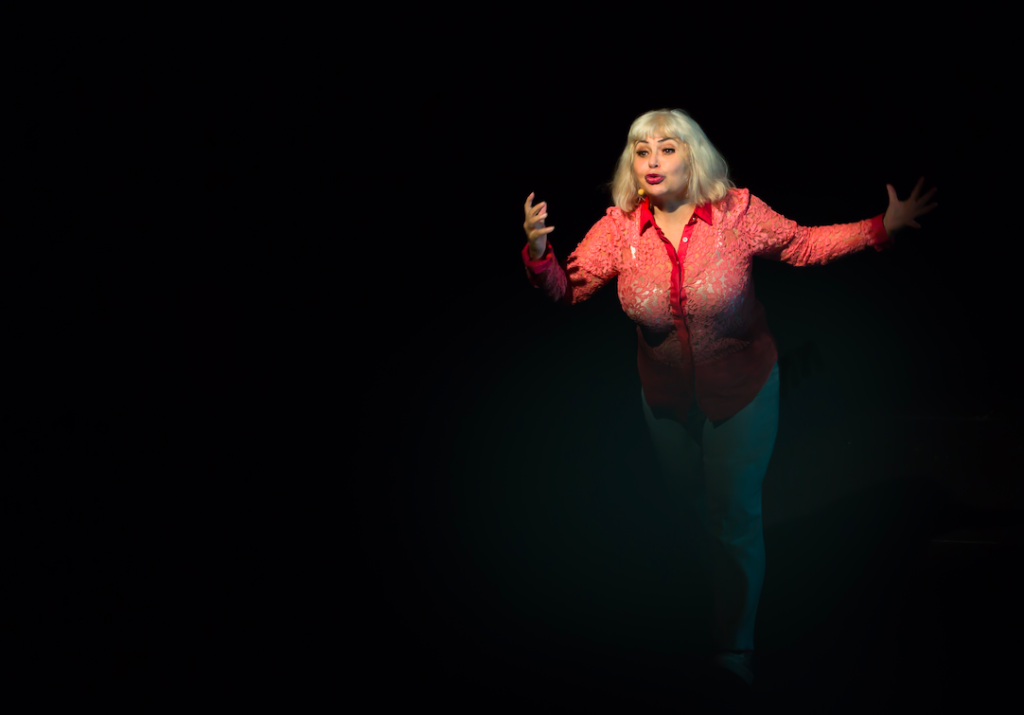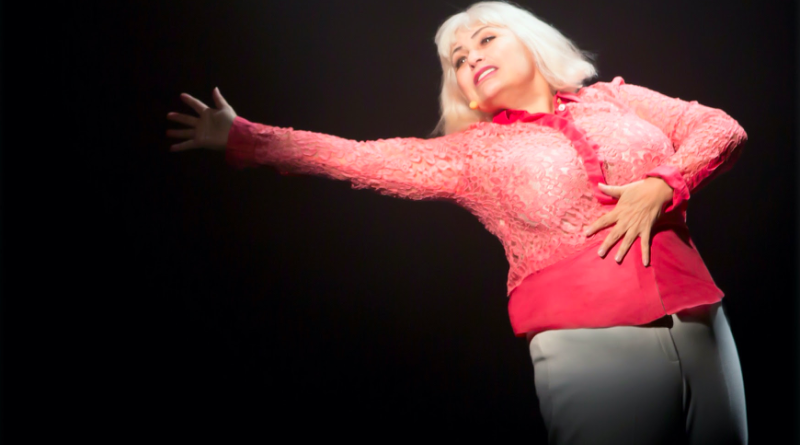INTERVIEW: Penny Arcade on art being a vocation, not a profession
Photo: Penny Arcade performs in Longing Lasts Longer at The Players. Photo courtesy of Albie Mitchell / Provided by Emily Owens PR with permission.
Penny Arcade, the legendary performance artist, has had a storied career that encompasses just about every medium available, from theater to music to film and (in the future) even podcasting. One of her most acclaimed works, one that continues to endure years after its premiere, is Longing Lasts Longer, which finds Arcade on stage offering comedic and heartfelt takes on the important issues of gentrification, history and “cultural amnesia.”
Longing Lasts Longer will play a special one-night-only performance Thursday, April 27 at The Players, a members-only club in Downtown Manhattan. For the show, which comes to New York City courtesy of the White Horse Theater Company, Arcade will be joined by her frequent collaborator, Steve Zehentner, who will offer a rock ‘n roll soundscape during the 80-minute performance, according to press notes.
For the uninitiated, Arcade has been making art since the 1960s and her teenage years. There are many highlights to her biography, including being a member of the Playhouse of the Ridiculous and a “Warhol Superstar” at age 19. (Yes, that’s her in 1972’s Women in Revolt.) Her writing has been extensive over the years, resulting in 16 full-length plays and almost too many solo shows to count. New York audiences may remember her from an off-Broadway Tennessee Williams double bill alongside Mink Stole.
Recently Hollywood Soapbox exchanged emails with Arcade about Longing Lasts Longer. Questions and answers have been slightly edited for style.
What inspired you to put pen to paper and create Longing Lasts Longer?
Over the past 20 years we have been dealing with disinformation at an alarming pace. I feel that my job as an artist is to provide context from my point of view, to be in a sense, a map maker. I looked over what had been “true” across my lifetime, i.e. the ideas that formed liberal American political humanism over the past 60 years that I’ve been awake alive (since my teens), and we combined that with some of the best rock ‘n’ roll music of the past 60 years because we know that music goes deeper into the consciousness then words.
Steve Zehentner, my longtime collaborator and co-creator, and I have created this piece of solo theater that has roots in both Poet’s Theatre and “Lehrstuck” Lesson or teaching theatre. Again, as with all my work, it’s experiential — you have to experience it, and it’s very hard to explain to anyone who hasn’t seen it because it contains so many different theatrical and entertainment forms. Longing Lasts Longer is a very funny show — so some people experience it as stand-up, but it goes far beyond stand-up. I think of myself as a map maker these days, and I thought let me make a map of my political and cultural landscape. And let’s put the audience in it, and the audience can stand in that landscape and see what resonates for them and what’s true for them. And when the music plays 100 sound cues of the best rock ‘n’ roll music, everybody dispenses with being ‘the audience’ and has their own emotional experience, memories and even totally new experiences with that music in conjunction with my words.
Has the piece changed over the years you’ve performed it?
Longing Lasts Longer was created improvisationally in front of live audiences over 13 live performances in 2014. What does that mean? It means that I go on stage just with ideas, and the monologues and jokes and everything is created live with the audience. It’s a metaphysical act of live action performance. We have now done over 208 performances. This performance at The Players Club on April 27 will be performance 209. We have over 116 updated scripts, meaning that we continue to refine the show every time we perform it, and that’s how I have always worked. And that is how Steve, my longtime collaborator, works, and that’s how we continue to work. It’s a very exciting process.
What’s it like to collaborate with Steve Zehentner?
Steve Zehentner and I are in our 31st year of collaboration, and at this point, and for many years, probably for at least the last 12 years, there’s been a lot of blurring between what he brings and what I bring. I mean fundamentally, Steve holds the overview, and I’m the detail person. I’m the writer. I write 96% of it, but Steve always brings in salient texts and asks the questions that clarify the work. Steve does the sound score, but I contribute to it. When we use video, Steve designs the video, but I contribute to it. Our collaboration is an incredibly organic process. There is nothing ‘academic’ about it. Here’s the weird thing, we’ve done over 208 performances of Longing Lasts Longer, and Steve still laughs and he still tears up at certain points. I don’t think there is greater proof of being in the moment than that. I wish everyone could have a collaboration like Steve and mine because it is so much fun, and it is so rich. It’s really rooted in our values. We share the same values, and we share complementary aesthetics.
How difficult is it to be an independent artist in 2023?
Being an independent artist in America hasn’t really changed since time in memoriam — it means that you are not connected or beholden to any institutions financially and are free to make work as you want. However, it also means you are much less likely to get financial support. As an independent artist today, after almost 30 years of Emerging Arts sucking up all the financial support for artists in America, one remains on the sidelines of financial support for one’s work. You could say I make work through the support of the wide audience that has supported my work by buying tickets and the very special independent donors who contribute to us. The Emerging Arts movement comes out of academia. It doesn’t come out of the art world. There were always young artists who became old artists. We didn’t need a hothouse environment so young seedling artists could develop. Emerging Arts is an academic idea — the entire funding process is a reward for student artists who go through academia. It would be very interesting to see a study of how many young artists continue past the funding stages.
Being an independent artist is a question of not losing your nerve. I think that probably right now that’s my greatest contribution to other artists — to be a model for continuing to make work decade after decade.
What was it like working at the Playhouse of the Ridiculous?
John Vaccaro’s Playhouse of the Ridiculous was the breeding ground for so much that is in contemporary culture. John Vaccaro was an extraordinary showman. He wasn’t really an actor‘s director. He was a stager with big ideas and concepts, and his direction was more like directing a circus — somewhere between the lion tamer and a philosophical high-wire act. It was an extraordinary experience to be in a situation with someone like John who pushed you to go beyond your limits and in a sense collaborated with the whole company of 30 people — people who were many different ages and used what was good that came out of them.
I was mentored by John, not so much being personally coached by him, but by being allowed to improvise as much as I wanted, that and in observing Vaccaro, and people of his age group (he was in his 40s in the late 1960s). He was part of a very high-functioning scene of entrepreneurial independent artists, along with Jack Smith and Andy Warhol, Tom Horgan, Joe Chaiken, etc. It was really a high point in American theater, and it was exciting. And it taught me how to make theater iota by iota. It made me fearless in improvisation, and it made me deeply respect the artistic process.
When you look at the “youth culture” of today, what are your initial thoughts?
In many ways, it’s a pretty extraordinary time to be young. You have access to the internet with every kind of how-to tutorial that you’ll ever want. You can really research anything from any time. It’s pretty extraordinary for young people with a lot of curiosity, and I was one of those kinds of kids.
I was and remain very, very curious. It’s a pretty wonderful time to be young in that regard, and in the fact … there is so much encouragement for young people to pursue the arts, which did not exist when I was young. However, what is not so great is that the entire idea of intergenerational exchange has been erased, so young people do not get the benefit of knowing people who are much older than them or people who are much more accomplished than them. And I think that really slows down one’s progress and one’s ability to integrate.
Another debilitating factor for young artists is the overwhelming presence of ‘The Market’ in everything they undertake. Art is not a profession; it is a vocation. The other thing is that young artists are making work under one of the most stifling periods of social censorship — and I think it really creates work that is forced to defend and prove itself to be towing the company line about everything that theatre is supposed to explore. I’m holding out for the tadpoles who are going to realize that they are being manipulated by the marketplace and are going to jump to it and be the ones who are breaking new ground. That’s what I’m waiting for, and I hope I live to see them accomplish that.
By John Soltes / Publisher / John@HollywoodSoapbox.com
Longing Lasts Longer, written, conceived and performed by Penny Arcade, plays a special one-night-only engagement Thursday, April 27 at The Players. Click here for more information and tickets.


